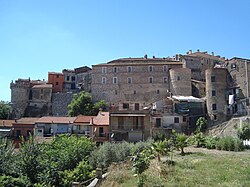Mentana
Mentana | |
|---|---|
| Comune di Mentana | |
 | |
UTC+2 (CEST) | |
| Postal code | 00013 |
| Dialing code | 06 |
| Patron saint | St. Nicholas of Bari |
| Saint day | December 6 |
| Website | Official website |
Mentana is a town and comune, former bishopric and present Latin Catholic titular see in the Metropolitan City of Rome, Lazio, central Italy. It is located 29 kilometres (18 mi) north-east of Rome and has a population of about 23,000.
History
Mentana is a town located in the region of Lazio in central Italy. The town's name in ancient times was Nomentum, to which the Via Nomentana led from Rome.[3] According to Livy, the town was part of the Latin League, which went to war with Rome during the reign of Rome's king Lucius Tarquinius Priscus. Nomentum was one of a number of towns captured by Tarquinius.[4]
It was a Latin town, but was considered by some to be
Subsequently, Nomentum received the civitas sine suffragio, and in its municipal constitution the chief magistrate even in imperial times bore the title of dictator.
In 741, it was briefly occupied by the Lombards, and the inhabitants moved to a new centre on the Via Nomentana, which was more easily defendable. On 23 November 799, it was the site of the meeting of Pope Leo III and Charlemagne.
The Castle of Nomentum was a possession of the Roman family of the
In the 15th century, it was under the control of the

On 3 November 1867,
Ecclesiastical History
In 408 AD Nomento is mentioned as an episcopal see (established circa 40 AD), and in February 593 it gained the territory of the suppressed annexed the Roman Catholic Diocese of Passo Curese (Cures Sabinorum, Curi).
In May 944 it was suppressed, its territory being merged into the diocese of Vescovio.
The diocese was nominally restored as a Latin Catholic
It has had the following incumbents, of the lowest (episcopal) and once archiepiscopal (intermediary) ranks :
- Emanuele Gerada (1967.02.15 – 1973.11.08)
- Titular Archbishop Emanuele Gerada (1973.11.08 – 2011.01.21)
- Habib Chamieh, San Charbel en Buenos Aires of the Maronites(Argentina).
Main sights
- The Castle (c. 1000), housing the Archaeological Museum and is a site of art exhibitions.
- Palazzo Crescenzio
- Funerary Monument of the Appulei, a 2nd-century BC travertine frieze
- Museum of the Risorgimento
- Science Museum.
- The Nature Preserve of Nomentum includes the Trentani Park and the Macchia (Maquis shrubland) of Gattacieca, the remains of the ancient city as well as a necropolis of the 8th century BC.
References
- ^ "Superficie di Comuni Province e Regioni italiane al 9 ottobre 2011". Italian National Institute of Statistics. Retrieved 16 March 2019.
- ^ "Popolazione Residente al 1° Gennaio 2018". Italian National Institute of Statistics. Retrieved 16 March 2019.
- ^ Corrado Pala; Unione Accademica Nazionale (1976). Forma Italiae: Latium et Campania. Nomentum. De Luca Ed.
- Ab urbe condita, 1:38
- ^ Seneca, Epistles,
 civ. 1.
civ. 1.
- ^ Seneca, Epistles,
 cx. 1.
cx. 1.
- OCLC 1120365200.
- ^ Giuliano Procacci History of the Italian People London: 1970 p.331
Source and External links


